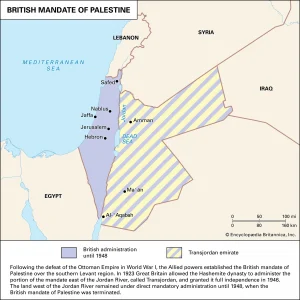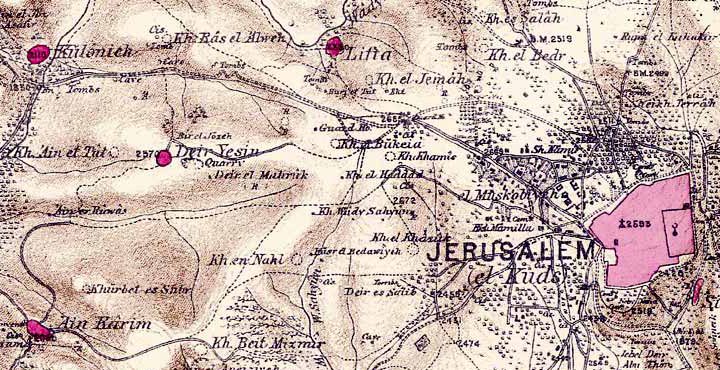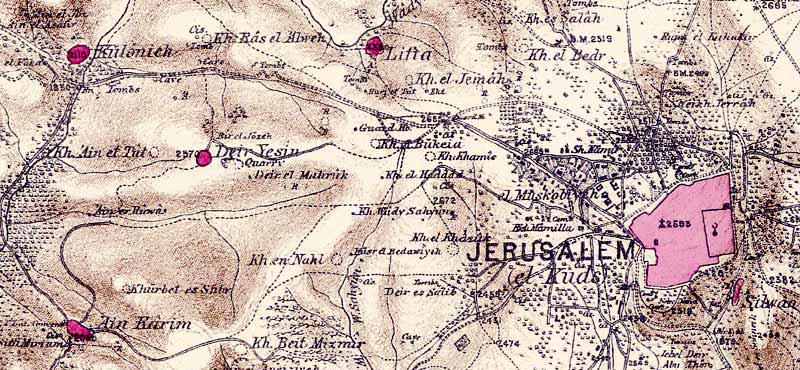As Israel wages war against Hamas in Gaza, many Americans have declared themselves armchair generals who think they understand everything about one of the most complex geo-religio-political conflicts in world history.
Dear readers, Facebook is a poor resource for a history of Palestine. The dependence on emotional proof, misinformation and the imposing of personal prejudices on the facts make sorting through all the claims an impossible task.
The history begins with the very name of the place in question. Some argue there never has been a place called “Palestine.” Others argue “the Palestinians” already occupy dozens of other countries and ought to leave Israel alone. Still others warn Israel has continued to expand its occupation of “Palestine” and is an intruder.
Britannica explains: “The name ‘Palestine’ has long been in popular use as a general term to denote a traditional region, but this usage does not imply precise boundaries.”
“The history begins with the very name of the place in question.”
And: “The word ‘Palestine’ derives from ‘Philistia,’ the name given by Greek writers to the land of the Philistines, who in the 12th century BCE occupied a small pocket of land on the southern coast, between modern Tel Aviv–Yafo and Gaza.”
Thus, Palestine as a geographic region does indeed have an ancient history. Anyone who claims it does not hasn’t studied enough history.
Again from Britannica: Palestine is defined as the “area of the Eastern Mediterranean region, comprising parts of modern Israel and the Palestinian territories of the Gaza Strip (along the coast of the Mediterranean Sea) and the West Bank (west of the Jordan River).”
Any remedial student in a Baptist children’s Sunday school class will immediately recognize some of the key names mentioned thus far in this description. But how did today’s boundaries come to be?
God told us to do it
Modern-day Israel has been very successful in selling a narrative about its ownership of the land. How have they done this? The God story.
Israel’s story has mesmerized American evangelicals so completely that it is hard to tell who is more invested in Israel, the citizens of Israel, the Jewish population in the rest of the world, or evangelical Christians. Israel is a secular nation, but its foundation as a nation rests on the claim of God and the acceptance of the narrative of the Hebrew Bible.
For example, one Facebook post shows the skyline of Jerusalem with the words, “Israel doesn’t occupy the land. They OWN it. Genesis 15:18–21.
Here’s what that passage says: “On that day the Lord made a covenant with Abram, saying, ‘To your descendants I give this land, from the river of Egypt to the great river, the river Euphrates, the land of the Kenites, the Kenizzites, the Kadmonites, the Hittites, the Perizzites, the Rephaim, the Amorites, the Canaanites, the Girgashites, and the Jebusites.’”
Part of this territory was indeed the Promised Land of Old Testament fame, the land Moses led his people to but could not cross over to occupy himself.
This is one part of a war-torn story. Palestine may be the most blood-soaked territory in the world.
Seven flags over Palestine
Kings and kingdoms have risen and fallen over the centuries in Palestine. How many flags have flown over Jerusalem in her history? If Americans were in charge in Israel, there would be an amusement park in a Jerusalem suburb called Seven Flags over Jerusalem.
The rulers of Palestine have included: Ancient Egypt, Ancient Israel and Judah, the Persian Empire, Alexander the Great and his successors, the Hasmoneans, the Roman Empire, several Muslim caliphates, and the Crusaders.
The biblical account of Israel’s conquest of Canaan has historical parallels to Israel’s invasion of Gaza. The party line — said to be God’s command — called for the destruction of all Canaanites as the Israelites came to occupy the Promised Land.

Britannica
But this didn’t happen. There’s an alternative story in the biblical account: There were good Canaanites. Rahab, the Canaanite prostitute, was the first person to declare faith in Israel’s God in the bounds of the Promised Land. Israel did not carry out the complete annihilation of all the Canaanite nations.
Most Sunday school lessons end right there. The Children of Israel occupied the Promised Land, and everyone lived happily ever after.
Keep reading in the Hebrew Scriptures and you’ll learn of wars and more wars — ultimately ending in the destruction of the Jerusalem Temple in 70 CE and all of Jerusalem by 73 CE.
That created a diaspora not only of Jews but also of early Christians.
A minority remained but the majority settled in Europe and other parts of the Arab world. From 136 CE until the start of First Aliyah of Jews migrating to Palestine in 1882, the Jewish presence in Palestine was minimal. There were more Christians in Palestine in these centuries than Jews.
In the intervening centuries, Palestine also endured the horrors of eight crusades by the Catholic Church. War in the name of God seems a constant theme. The Ottomans of Turkey ruled Palestine for 400 years.
Then came the British Empire ruling Palestine from 1929 to 1949.
But after World War II and the Holocaust, Palestine has been divided into Israel, the West Bank and the Gaza Strip.
Constant conflict
When the World War II allies forcibly created the modern political state of Israel in 1948, there were other people living there. They were expelled, forced to move to other places by the tens of thousands. That generated animosity that continues to this day. And then Israel began fighting to expand beyond the borders assigned to it by the Allies, further alienating people already living there.
That practice continues into the present day as Jewish settlers push deeper into the West Bank, claiming even more land.
Palestine, in world history, seems to be a small, curved, elegant neck with the boots of the world’s empire stomping on it constantly.
Take two peoples (Jews and Arabs), the three dominant religions (Judaism, Christianity and Islam), the political powers of the world (USA, Great Britain and Russia) and one small land the size of the state of Maryland. Crowd 13 million people into the space. Put the Palestinians in refugee camps in Gaza and the West Bank. That’s the formula for unending war.
The conflict has existed in its latest form for at least 75 years. According to Michael Scott-Baumann, in The Shortest History of Israel and Palestine, “The conflict is a dispute between Jewish immigrants and their descendants who have followed the ideology of Zionism and the Palestinian Arabs among whom the Zionists settled. Both claim the right to live in, and control, some or all of Palestine.”
The modern history of Palestine and Israel
Imagining Israel as a modern nation began when Theodor Herzl, a lawyer and journalist, wrote a book titled The Jewish State, published in 1896. He called for the Jews to form a single nation-state like that of France or Germany.
Jews had dreamed of returning to Eretz Israel, the biblical “Land of Israel,” for hundreds of years. Herzl made this dream a conscious process.

Brittanica
Most Jews living abroad saw Palestine, in the words of the writer Israel Zangwill, “a land without a people for a people without a land.” The region of Palestine was seen as a desolate, sparsely populated country. The ability to make the Palestinian people “invisible” has been a major propaganda victory for Israel.
By 1914, the two communities were consumed by their desire for the same land. The Arabs felt they were the rightful owners. The Zionists began a systematic purchase of as much land as possible to stake a claim to a Jewish homeland. The Jews perfected the common law understanding of “squatter’s rights.”
The next step in Israel becoming a nation was the Balfour Declaration in 1917. The British Foreign Secretary, Arthur Balfour, sent a letter to Lord Rothschild, a leading British Jew, expressing support for a national home for the Jews in Palestine.
In 1920, at an international conference in San Remo, Italy, both Britain and France acquired mandates over the Arab lands that were taken from the defeated Ottomans. The Palestinians believed they had exchanged one set of oppressive colonial powers with another set with the same negative results. After all, colonialism, even when cloaked in presumed righteousness and benevolence, has perverse leanings toward oppression.
The Balfour Declaration was then formalized by the British Mandate, which favored the Jews. The mandate encouraged Jewish immigration and the Jewish settlement on the land. The United States concurred, aided and abetted by an evangelical theology of dispensationalism that insists the Jews were God’s chosen people and God had plans for Israel in the ending scene of earth’s existence.
Obviously, Palestinian Arabs opposed the Jewish “right of return” to their ancient homeland. Israel’s biblical story has no standing among Palestinians. The Arabs claimed Palestine based on the natural right of a settled population as the land of their birthright. They also believed Great Britain had a contractual obligation to recognize Arab rights to the land. None of this came to fruition. Great Britain sided with the Jews.
British rule
Under the British, Palestinian rights were of little concern. According to Palestinian historian Rashid Khalidi, the Arabs of Palestine felt they were being kept in an “iron cage.”
As Scott-Baumann notes, “An irrepressible conflict has arisen between two national communities within the narrow bounds of one small country. There is no common ground between them. Their national aspirations are incompatible.”
Then World War II and the Holocaust changed everything. Given the horrific deaths of 6 million Jews in Hitler’s “Final Solution,” international support for creating a permanent homeland for the Jewish people gained support from all the Allies.
Thus, in 1948 the British left Palestine, and the modern state of Israel was established.

Maps from Britannica
Israeli and Palestinian narratives differ markedly, particularly on the exodus of Palestinian Arabs and Israel’s victory in the war that followed. From May 1948 to January 1949, 400,000 Palestinian Arabs fled. Most ended up in Gaza or on land bordering the West Bank of the Jordan River. The Arabs label this event as the Nakba, the catastrophe or disaster.
More than half the Arab population of Palestine was displaced between 1947 and 1949 — 700,000 people out of a total of 1.35 million. Most of these refugees went to the West Bank or Gaza, the parts of Palestine that were not incorporated into the new State of Israel. The majority ended up living in tents in hastily constructed camps. Today there are more than 5 million UN-registered Palestinian refugees, mostly descendants of those who were made homeless in 1948 and 1949.
According to the Palestinians, Jewish forces engaged in the forcible expulsion of Arabs from inside what was to become Israel. The Jews claimed the Arabs left willingly. In any event, nearly all the villages along the coast from Tel Aviv to Haifa were cleared of their Arab populations.
The Six-Day War, 1967
At dawn on the morning of Monday, June 5, 1967, Israel carried out air strikes that wiped out nearly all the air forces of Egypt, Syria and Jordan. Israel captured Egypt’s Sinai and Syria’s Golan Heights within six days. In addition, Israeli forces also seized Gaza (from Egypt) and the West Bank (from Jordan). At this point, Israel controlled all of what had been Mandatory Palestine. The map of the Middle East now looked like the map of Israel under King David.
Undeterred by the devastating losses, the Arab League, at a conference in August 1967, declared: “No peace with Israel, no recognition of Israel, no negotiation with it. We insist on the rights of the Palestinian people in their country.”
Whatever peace there was lasted only until October 1973. On the day of Yom Kippur, the holiest day of the Jewish year, Arab forces attacked Israeli troops occupying Sinai and the Golan Heights in a secretly coordinated attack. After suffering initial setbacks, Israel regrouped and won the war.
The war continues
Resistance to Israel has continued, however, not in the form of identified states but in groups such as Hamas, which has been labeled by the U.S. and others as a terrorist organization. Hamas gained political control over Gaza, but Gaza and Hamas are not the same thing.
The Hamas surprise attack on Israel Oct. 7 is another “eye for an eye” excursion that directs all relationships in the Middle East.
This time, however, Hamas may have underestimated the Israeli response. Instead of “an eye for an eye,” Israel launched a war of “unconditional retaliation.” Viewing Oct. 7 as their 9/11, Israel vowed to destroy Hamas and has killed 35,000 Palestinians in the process.
Israel, led by the hawkish Benjamin Netanyahu, sees the conflict as a matter of Israel’s life and death, survival or destruction.
Around the world, there are signs Israel is losing the narrative battle. The “God narrative” seems to be losing some of its mysterious power among an increasingly secular population. Israel now stands accused of genocide by some world leaders — even in the U.S.
The Facebook meme battles, the student protests, the voluminous recriminations by opinionators seem naïve and superficial compared to the human suffering in Palestine and the complex issues of two people vying for one land.
From biblical times to the present, in Palestine a voice is still heard in Ramah. If you go outside at night, walk along the beach in Gaza, you can imagine you see the ragged ghosts of an endless army tramping in the sand, wearing the colors of many nations, because every night they walk the beach and every night you can hear lamentation and bitter weeping from Rachel, Rahab and all the mothers of Israel and Palestine weeping for their children, “refusing to be comforted for their children, because they are no more.”
Rodney W. Kennedy is a pastor and writer in New York state. He is the author of 10 books, including his latest, Good and Evil in the Garden of Democracy.


